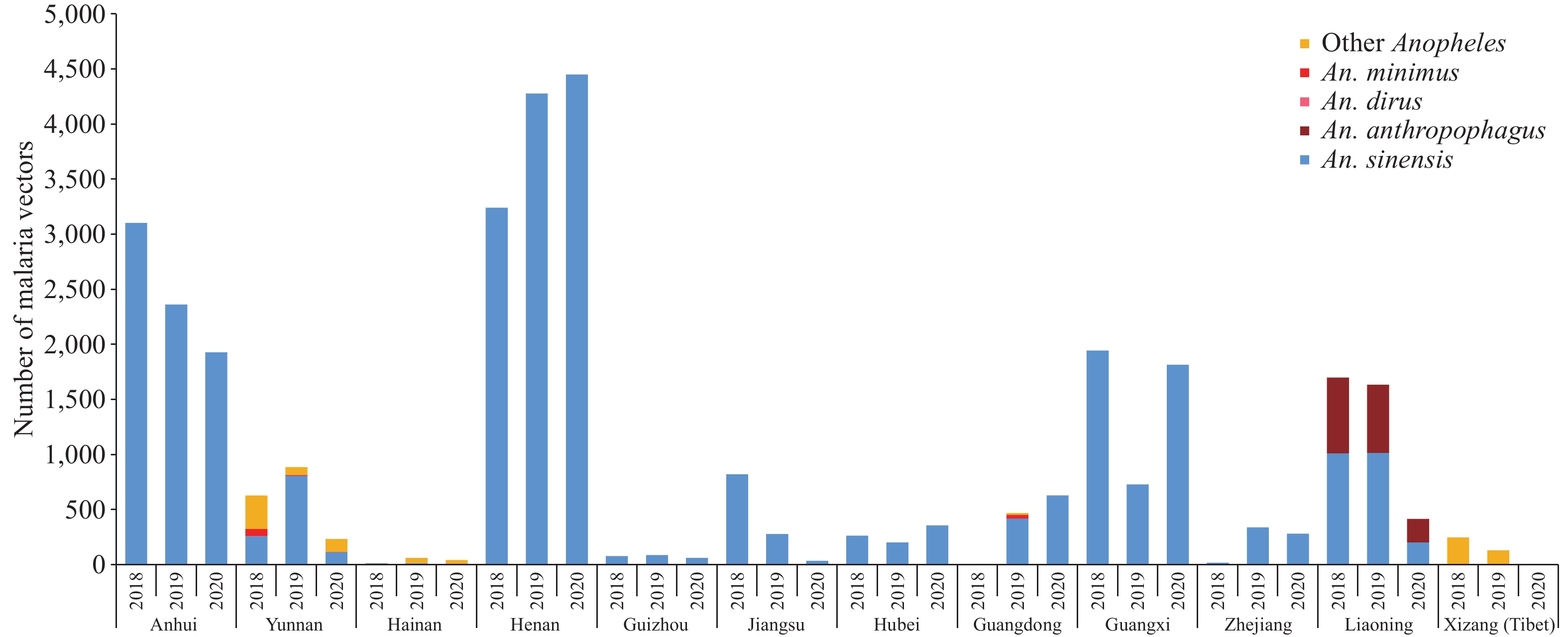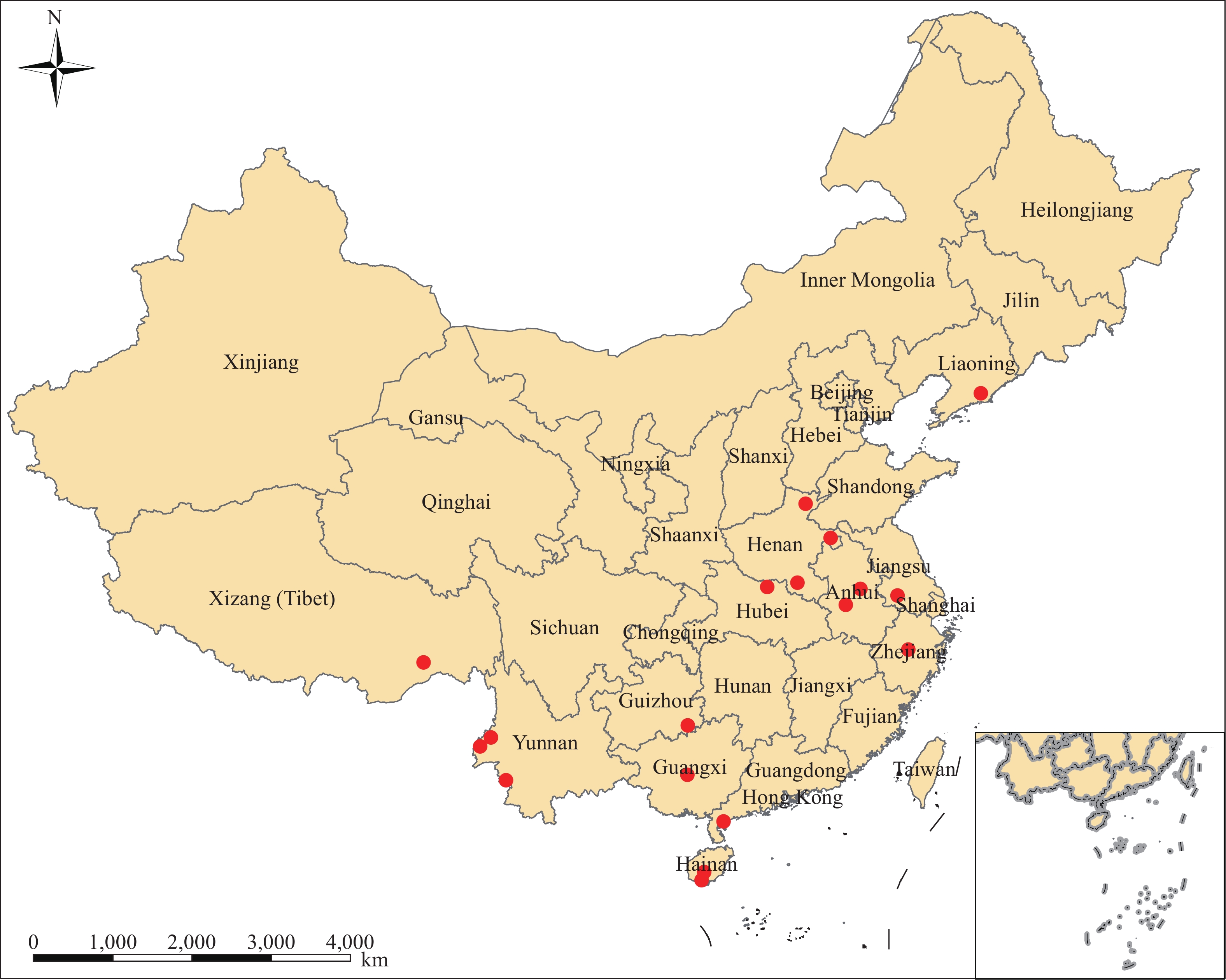-
Malaria is an infectious parasitic disease transmitted through the bite of Anopheles mosquitoes, which seriously endangers human health (1). Although significant progress has been made on malaria control in several countries, the infection is still on the list of top health threats to humans, causing 409,000 deaths worldwide in 2019 [World Health Organization (WHO), World Malaria Report 2020]. Historically, high malaria incidence rates have been reported from 24 provincial-level administrative divisions (PLADs) of China (2). Following several decades of prevention and control, the Central Government of China with strong political commitment in malaria elimination since 2010, endorsed the National Action Plan for Malaria Elimination (2010–2020) with the goal of malaria-free nationwide by 2020 (3). The last indigenous case of malaria in China was reported in April 2016 in Yunnan Province; since then, zero indigenous case has been reported in the country (4). In order to further strengthen the surveillance capacity for post-elimination phase and meet the requirement of malaria certification. Surveillance has been carried out in areas at high risk of malaria transmission based on various indicators, such as the distribution of Anopheles spp., the number of imported cases, and the risk of re-establishment of malaria transmission in China. This study aims to describe the population distribution, density, and seasonal fluctuations of Anopheles spp. at the sentinel sites (n=18) for malaria vector surveillance from 2018 to 2020. The results showed that same malaria vectors were found in the surveillance regions, but with significant discrepancy of species distribution and seasonal fluctuation. The study will help advance our knowledge in providing baseline data for the prevention and control of imported malaria cases to consolidate the achievements of malaria elimination in China.
The statistical data of this study were achieved using information from the malaria vector surveillance system in the national malaria zero indigenous case reporting phase, 2018–2020. All 18 national malaria sentinel sites in 12 PLADs of China were enrolled for malaria vectors surveillance during the malaria transmission phase (Figure 1). According to the strategy in the “National working program for malaria vector surveillance leading for malaria elimination certification in China”, lamp trapping and human-baited tent trap methods were used to monitor the population distribution, density, and seasonal fluctuation of Anopheles vectors, and quality control was carried out by Provincial and National CDCs. Microsoft Excel software (version 2016, Microsoft, USA) was used to analyze the surveillance data.
From 2018 to 2020, a total of 33,727 Anopheles spp. mosquitos were captured by the lamp trapping method in 18 surveillance sites. From these, numbers of 31,126 An. sinensis, 1,520 An. anthropophagus, 111 An. minimus, and 970 other Anopheles spp. were identified by morphological analysis (Figure 2). An. dirus was not identified. The distribution and density of Anopheles spp. in different areas was significantly different. The proportions of An. sinensis, An. anthropophagus, and An. minimus in the total number of Anopheles spp. were 92.29%, 4.51%, and 0.33%, respectively. An. sinensis was the most widely distributed and was detected in all areas except Motuo County, Xizang (Tibet) Autonomous Region. An. anthropophagus was only detected in Donggang City, Liaoning Province. An. minimus was found distributed in Yunnan and Guangdong Provinces.
 Figure 2.
Figure 2.The number of malaria vector captured by lamp trapping method in 12 monitoring PLADs, 2018–2020.
Abbreviations: PLAD=provincial-level administrative divisions; An. minimus=Anopheles minimus; An. dirus=Anopheles dirus; An. anthropophagus=Anopheles anthropophagus; An. sinensis=Anopheles sinensis.Density and seasonal fluctuations of malaria vectors were monitored by human bait trapping methods in all surveillance sites. However, Motuo County in Xizang (Tibet) Autonomous Region was not monitored as required and was not included in the analysis. The monitoring results of the average density of malaria vectors in the surveillance sites from 2018 to 2020 were included in the density monitoring analysis and are shown in Table 1. A total of 5,481 Anopheles were captured by human bait trapping method in 17 surveillance sites, including 5,326 An. sinensis, one An. anthropophagus, 85 An. dirus, 24 An. minimus and 45 other Anopheles spp., which were different from those captured by lamp trapping method. An. anthropophagus was only detected in Congjiang County, Guizhou Province; An. dirus was detected in Wuzhishan City, Hainan Province; and An. minimus was detected in Hainan, Yunnan, and Guangdong Provinces. From 2018 to 2020, the average density of captured malaria vectors was significantly different among the surveillance sites, with the distribution range ranging from 0 to 9.15 (numbers per man per hour). Anhui and Henan provinces had the highest density distribution of Anopheles spp. Among 17 surveillance sites in 11 PLADs from 2018 to 2020, Zhejiang Province had only 1 An. sinensis, Wuzhishan City of Hainan Province had the peak malaria vectors density in May, Tengchong City and Yingjiang County of Yunnan Province, Tianya District of Hainan Province, Donggang City of Liaoning Province, and Congjiang County of Guizhou Province had peak malaria vector abundance in August, and the remaining 10 surveillance sites had a peak in Anopheles abundance between June and July.
PLADs Surveillance site Average density (number/person•hour) Early May Late May Early Jun Late Jun Early Jul Late Jul Early Aug Late Aug Early Sep Late Sep Early Oct Late Oct Anhui Feidong 1.53 1.80 4.87 6.83 4.32 5.65 2.90 1.98 2.40 1.50 0.70 0.99 Shucheng 0.00 0.01 0.33 0.35 1.64 1.67 1.25 0.52 0.14 0.04 0.06 0.03 Yunnan Tengchong 0.00 0.00 0.00 0.00 0.00 0.04 0.08 0.17 0.04 0.08 0.09 0.13 Cangyuan 0.42 0.22 0.47 0.17 0.47 1.39 0.19 0.31 0.20 0.17 0.00 0.08 Yingjiang 0.11 0.31 0.45 0.06 0.17 0.31 0.86 0.50 0.36 0.03 0.00 0.03 Hainan Tianya District 0.30 0.47 0.43 0.53 0.50 0.50 0.83 0.93 0.83 0.90 0.37 0.23 Wuzhishan 0.73 0.29 0.48 0.31 0.40 0.21 Henan Yongchen 0.00 0.17 0.14 0.06 1.64 0.00 0.00 0.00 0.03 0.00 0.00 0.00 Shihe − − 2.75 9.15 3.85 6.00 2.50 1.90 2.55 1.30 0.20 0.00 Puyang 0.00 0.00 0.17 3.03 6.03 7.31 4.75 2.59 0.72 0.50 0.00 0.00 Guizhou Congjiang − 0.34 0.31 0.39 0.07 0.01 Jiangsu Jintan 0.00 0.00 1.11 1.63 2.81 2.33 0.75 1.21 1.07 0.60 0.38 0.07 Hubei Zaoyang − − 2.90 2.97 2.13 0.90 1.20 0.87 0.20 0.07 0.00 0.00 Guangdong Potou 0.00 0.07 0.00 0.04 0.00 0.00 0.00 0.00 0.00 0.00 0.01 0.00 Guangxi Shanglin − 0.31 0.11 0.13 0.06 0.03 Zhejiang Yiwu 0.00 0.03 0.00 0.00 0.00 0.00 0.00 0.00 0.00 0.00 0.00 0.00 Liaoning Donggang 0.00 0.00 0.00 0.00 0.00 0.05 0.16 0.45 0.00 0.00 0.00 0.00 Note: − : Not monitored
Abbreviation: PLAD=provincial-level administrative division.Table 1. Results of malaria vector average density surveillance by the human bait trapping methods in 17 sentinel sites, 11 PLADs, China, 2018–2020.
-
The results from this study showed that An. sinensis, An. anthropophagus, An. minimus, and An. dirus were still the main malaria vectors at the stage of zero indigenous malaria case reported in China (5). The same malaria vectors existed with significant discrepancy of species distribution and seasonal fluctuation in the surveillance regions. There have been no reports of indigenous malaria infection in China for 4 consecutive years since 2017 (6). However, with the intensification of globalization, the number of people coming from or returning from malaria-endemic areas has gradually increased, making imported malaria a major threat to the elimination of malaria in China (6). Imported malaria cases will exist for a long time after the elimination of malaria in China, a high risk of malaria re-transmission in areas where Anopheles spp. still exist (6). Therefore, continuous surveillance of malaria vectors and analysis of surveillance data are of highest importance for maintaining malaria-free status in China.
The results obtained in this study were consistent with those from previous studies. First, An. sinensis is widely distributed with a high population density and it is still considered of being an important vector for Plasmodium vivax malaria. Except in Xizang (Tibet), the vector, was detected in all surveillance sites, with the highest density in Henan and Anhui provinces. Second, from 1998 to 2001, An. anthropophagus was found in 205 counties of 11 PLADs in China (7). From 2005 to 2010, it was captured in 13 counties in 7 PLADs, including Henan, Hubei, Guangdong, Hainan, Sichuan, Guizhou, and Yunnan (5). However, from 2018 to 2020, it was only detected in Liaoning and Guizhou provinces, indicating that the spatial distribution of An. anthropophagus became smaller than before. Third, mosquitoes of the An. minimus group were recorded from 16 PLADs in southern China, such as Hubei, Henan, Anhui, Zhejiang, Yunnan, Guizhou, Guangxi, and Hainan (5). From 2005 to 2010, An. minimus was captured at 5 surveillance sites in Fujian, Guangdong, Hainan, Guizhou, and Yunnan provinces (5). However, it was detected only in Hainan, Yunnan, and Guangdong provinces during 2018–2020. Fourth, An. dirus was only detected in Hainan Province. In summary, the distribution of An. anthropophaga, An. minimus, and An. dirus fitted well with the areas at risk for malaria re-transmission (8), which provided the references to malaria elimination certification. In contrast, the seasonal distribution patterns of An. sinensis in the 2018–2020 surveillance differed from the previous records that An. sinensis had a classic peak of abundance each year in the rainy season (July–August), while the other malaria vectors had the peak of abundance during August–September in the surveillance sites in 2005–2010 (5).
The study was subject to some limitations. First, the identification level of mosquito species was different in 12 monitoring PLADs. Second, some individual sentinel sites were not monitored due to natural weather conditions, such as that in Xizang (Tibet).
This study reports the first systematic surveillance of malaria vectors in the malaria elimination phase in China, with wide coverage and high representativeness. The surveillance area could be roughly divided into three regions. The southern and southeastern regions of China had high risk for malaria re-transmission and had more detected species of malaria vectors, which may be due to the existence of more suitable breeding sites for Anopheles spp. (5,9). The high density of An. sinensis in central China, located in the climate sensitive zone for malaria transmission, may be related to the high number of malaria cases in the past (9-10). In northeastern region, where climate change is likely to cause an increase in the prevalence of P. vivax in the country, there may be significant risk due to the presence of An. anthropophagus with high ability for malaria transmission. In addition, the surveillance for malaria vectors is from May to October. Due to the increase of global warming, the seasonal fluctuations of Anopheles spp. and their density in some southern, southeastern, and central region sentinel sites cannot be fully reflected. Therefore, it is necessary to frequently carry out standardized and comprehensive surveillance of malaria vectors. According to monitoring results, different areas are classified with different risk levels for malaria re-transmission, and then different targeted prevention and control strategy can be formulated and combined with the surveillance results of imported malaria cases.
HTML
| Citation: |




 Download:
Download:




